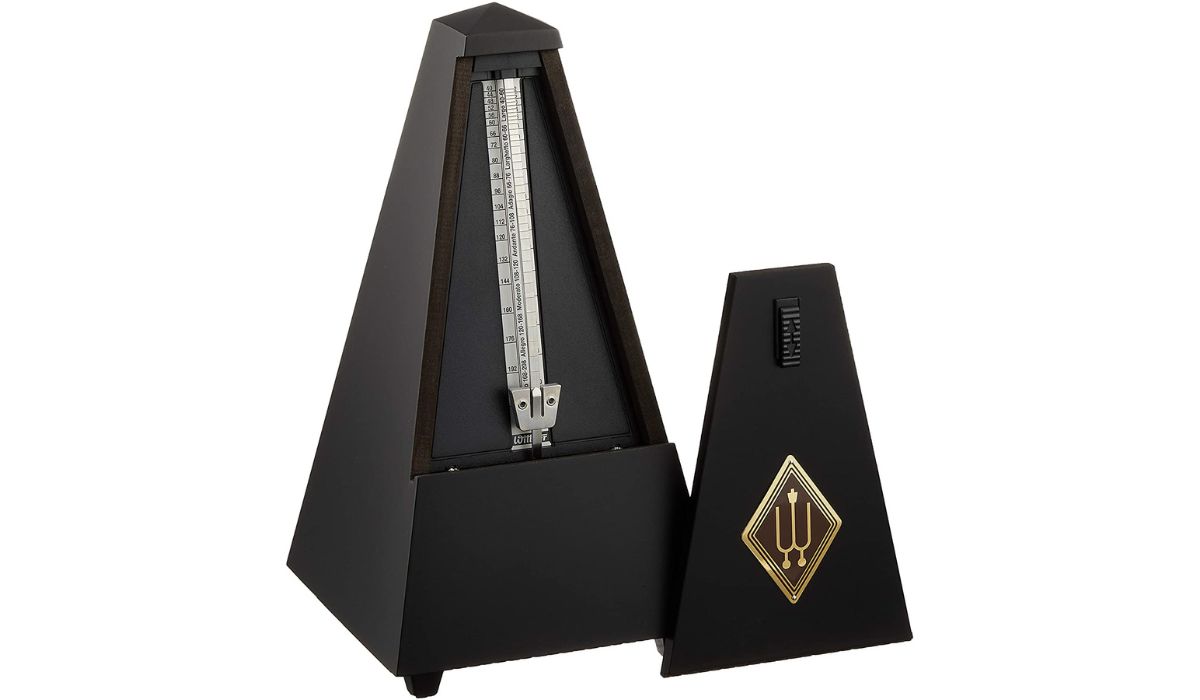Home>Production & Technology>Metronome>What Is The Meaning Of The Giant Metronome In Prague?


Metronome
What Is The Meaning Of The Giant Metronome In Prague?
Published: January 15, 2024
Discover the symbolism and significance of the giant metronome in Prague, a captivating landmark that stands as a testament to the city's rhythm and artistic spirit. Uncover the deeper meaning behind this iconic structure often associated with the passage of time and the vibrant pulse of Prague.
(Many of the links in this article redirect to a specific reviewed product. Your purchase of these products through affiliate links helps to generate commission for AudioLover.com, at no extra cost. Learn more)
Table of Contents
Introduction
The Giant Metronome in Prague is a well-known landmark that holds a special place in the city’s cultural history. This large-scale mechanical timekeeping device has become an iconic symbol of Prague, attracting tourists and locals alike. Located on Letná Park, a hilltop in the city, the Metronome offers stunning views of the Vltava River and Prague Castle.
The Metronome serves not only as a functional timekeeping tool but also as a symbol of Prague’s rich artistic and musical heritage. It has become a popular meeting point for locals and a gathering place for various cultural events. But what exactly is the meaning behind this giant structure, and why does it hold such significance for the people of Prague?
In this article, we will delve into the history, location, symbolism, and controversies surrounding the Giant Metronome and explore its importance in Prague’s cultural landscape. We will also examine the various interpretations and meanings ascribed to this intriguing monument. Whether you’re a history enthusiast, an art lover, or simply curious about Prague’s unique landmarks, this article will provide you with a comprehensive understanding of the Giant Metronome.
History of the Metronome
The history of the Giant Metronome dates back to the mid-1990s. Prior to its installation, the location was occupied by the world’s largest statue of Joseph Stalin, which was erected in 1955. The statue was a controversial symbol of the communist regime and was eventually dismantled in 1962. The empty pedestal remained a reminder of the country’s tumultuous past.
In 1991, a competition was announced for the redevelopment of the site, and the winning entry was a proposal to install a giant metronome as a nod to Prague’s rich musical traditions. The metronome was seen as a symbol of rhythm, precision, and the passage of time.
The installation of the Metronome took place in 1991, coinciding with the Velvet Revolution, a peaceful uprising that brought an end to communism in the Czech Republic. The timing of the Metronome’s installation added to its symbolic significance, representing a new era of freedom and artistic expression.
Designed by Czech artist Vratislav Novák, the Metronome stands at a height of 22 meters (72 feet) and features a giant swinging pendulum. Its scale and prominence make it a striking presence on the Prague skyline. The device itself is not functional, as it was designed purely for artistic and symbolic purposes.
Over the years, the Metronome has become an integral part of Prague’s cultural identity, creating a sense of connection between the city’s past and present. It serves as a reminder of the country’s complex history while also celebrating its artistic heritage.
Next, let’s explore the location and description of the Giant Metronome in more detail.
Location and Description of the Metronome
The Giant Metronome is located in Letná Park, atop Letná Hill in Prague. The park is a popular recreational area known for its picturesque views and lush greenery. The Metronome is situated on the site of the former Stalin monument, overlooking the Vltava River and offering breathtaking panoramic views of the city.
The Metronome itself is a massive structure, standing at a height of 22 meters (72 feet). Its design features a large stone pedestal with a platform that supports the metronome device. The metronome is made up of a swinging pendulum that hangs from a metal frame, representing the rhythmic motion of a traditional metronome.
The monument is constructed mainly of stone and metal, giving it a solid and durable appearance. Its prominent location and towering height make it a landmark that can be seen from various viewpoints in the city.
Adjacent to the Metronome is a spacious open area, often used for cultural events, music festivals, and gatherings. The space provides a platform for artists, musicians, and performers to showcase their talents against the backdrop of the iconic monument.
The Metronome’s placement in Letná Park has also made it a popular spot for locals and tourists to relax, take walks, and enjoy the stunning views of Prague. Many visitors choose to sit on the steps of the pedestal, soaking in the atmosphere and admiring the cityscape.
The location of the Metronome holds historical and cultural significance, as it marks the site once occupied by the statue of Joseph Stalin. The transformation from a symbol of oppressive communist rule to a symbol of artistic expression and freedom is a powerful testament to Prague’s resilience and embracing of its rich heritage.
Now that we’ve explored the location and description of the Giant Metronome, let’s delve into its cultural significance.
Cultural Significance of the Metronome
The Giant Metronome holds significant cultural importance in Prague and has become an integral part of the city’s artistic fabric. It serves as a powerful symbol of Prague’s rich musical and artistic heritage, as well as its ability to adapt and evolve with the changing times.
Prague has long been a center for music and has been home to renowned composers and musicians, such as Antonín Dvořák and Bedřich Smetana. The Metronome pays tribute to this musical legacy and acts as a constant reminder of Prague’s connection to the arts.
Moreover, the Metronome represents the city’s unwavering spirit and resilience. Its installation in 1991, after the fall of communism, marked a new era for Prague, one characterized by freedom, creativity, and self-expression. The monument symbolizes the city’s ability to transform and embrace its cultural roots while looking towards the future.
The Metronome has also become a prominent gathering place for various cultural events. The open area surrounding the monument serves as a stage for concerts, performances, and exhibitions. Musicians and artists from all over the world have graced this space, adding to the vibrancy and artistic energy of Prague.
Locals and tourists alike flock to the Metronome not only for its cultural significance but also for the breathtaking views it offers. The panoramic vista of Prague, with its iconic landmarks such as Prague Castle and Charles Bridge, creates a stunning backdrop for visitors to enjoy while appreciating the artistic allure of the Metronome.
Furthermore, the Metronome has become a popular meeting point and a symbol of urban life in Prague. Whether it’s meeting friends for a picnic, enjoying a walk in the park, or attending a cultural event, the Metronome has become intertwined with the daily lives of Prague’s residents.
Overall, the Giant Metronome represents Prague’s vibrant cultural scene, its indomitable spirit, and the city’s commitment to preserving and celebrating its artistic heritage. From its historical significance to its role in cultivating artistic expression, the Metronome continues to enrich the cultural tapestry of Prague.
Now, let’s explore the symbolism and interpretations associated with the Giant Metronome.
Symbolism and Interpretations of the Metronome
The Giant Metronome in Prague is more than just a mechanical timekeeping device – it carries profound symbolism and multiple interpretations that have captivated locals and visitors alike.
On a surface level, the Metronome represents the passage of time and the importance of rhythm in music. Just as a metronome provides a steady beat for musicians, the monument serves as a reminder of the essential role of rhythm and tempo in both music and life.
Furthermore, the Metronome symbolizes the city’s ability to keep time and adapt to changing circumstances. Just as the pendulum swings back and forth, Prague has experienced periods of upheaval and transition throughout its history, yet it has always found a way to maintain its cultural identity and embrace new artistic movements.
For some, the Metronome represents Prague’s resilience in the face of political and social change. It stands as a tangible reminder of the city’s ability to overcome past challenges and move forward with renewed energy and vitality.
Others see the Metronome as a symbol of artistic freedom and creative expression. Its location in Letná Park, a hub for artistic gatherings and events, reinforces this interpretation. The Metronome’s imposing presence encourages artists and musicians to push boundaries and explore new creative territories.
The pendulum’s oscillation also serves as a metaphor for the ebb and flow of life’s rhythms – the highs and lows, the moments of harmony and dissonance. It prompts contemplation on the fleeting nature of time and the importance of finding balance in one’s existence.
Additionally, the Metronome has been connected to political and social activism, particularly during the Velvet Revolution. It represents the power of collective action and the ability of citizens to stand up for their freedom and rights. Its installation after the fall of communism marked a turning point in Prague’s history, inspiring hope for a brighter and more inclusive future.
It’s important to note that personal interpretations of the Metronome may vary, as people bring their own perspectives and experiences to their understanding of the monument. Whether it evokes thoughts of artistic expression, societal change, or personal introspection, the Metronome allows individuals to connect with Prague’s history and culture in their own unique way.
Now, let’s explore the controversies and criticisms surrounding the Giant Metronome.
Controversies and Criticisms
While the Giant Metronome in Prague is widely revered and cherished, it has not been without its share of controversies and criticisms.
One of the major criticisms revolves around the removal of the statue of Joseph Stalin to make way for the Metronome. Some argue that erasing the statue completely erases a part of the city’s history, as it eliminates a tangible reminder of the country’s communist past. It has sparked debates about the proper preservation of historical landmarks and the importance of acknowledging all aspects of a nation’s history, no matter how controversial.
Another criticism stems from the argument that the Metronome lacks functional significance. Unlike traditional metronomes used by musicians to keep time, the Giant Metronome is purely symbolic and does not serve any practical purpose. Critics argue that this diminishes its value as a monument and could have been better utilized for a more functional or practical purpose.
There are also concerns surrounding the commercialization and overcrowding of the space around the Metronome. As the monument gained popularity, it has become a hub for tourists and vendors, leading to overcrowding and potentially detracting from its aesthetic appeal. Some argue that the commercialization surrounding the monument diminishes its cultural value and authenticity.
Additionally, there have been discussions about the aesthetic design of the Metronome. While some find its imposing stature and mechanical structure captivating, others feel that it lacks artistic finesse and does not integrate well with the surrounding landscape. Critics argue that a more subtle and harmonious design could have enhanced the overall aesthetic experience and integration within the park.
Despite these criticisms, it’s important to recognize that the Giant Metronome continues to hold a significant place in the hearts of many Prague residents and visitors. Its cultural significance, artistic symbolism, and ability to evoke emotions and contemplation make it a compelling monument within the cityscape.
Now, let’s delve into the restoration and maintenance efforts dedicated to preserving the Metronome.
Restoration and Maintenance of the Metronome
Over the years, the Giant Metronome in Prague has undergone various restoration and maintenance efforts to ensure its preservation and longevity as a cultural landmark.
Due to its exposure to the elements and the passage of time, the Metronome has required periodic restoration work to maintain its structural integrity and aesthetic appeal. The restoration process involves repairing any damages to the stone pedestal and metal framework, ensuring that the pendulum swings smoothly, and refreshing the surrounding area to enhance the overall visitor experience.
The restoration efforts are carried out by a team of skilled professionals, including architects, engineers, and conservationists, who carefully assess the condition of the monument and implement appropriate measures to safeguard its artistic and historical value.
In addition to restoration, regular maintenance is performed to keep the Metronome in optimal working condition. This includes routine inspections, cleaning, and ensuring that all parts are functioning properly. Any necessary repairs or adjustments are made to sustain the functionality and appearance of the monument.
Furthermore, the surrounding area and open space near the Metronome are also well-maintained. The park authorities take care to keep the area clean and tidy, ensuring that visitors can enjoy the park and appreciate the monument in a pleasant environment.
Local authorities and cultural organizations collaborate to fund the restoration and maintenance efforts for the Metronome. These initiatives are seen as crucial investments in preserving the city’s cultural heritage and maintaining the metronome’s significance as a symbol of Prague’s rich artistic legacy.
By prioritizing restoration and maintenance, Prague demonstrates its commitment to preserving the Metronome as a symbol of the city’s cultural identity for future generations to appreciate and enjoy.
Now, let’s conclude our exploration of the Giant Metronome in Prague.
Conclusion
The Giant Metronome in Prague is a captivating landmark that embodies the city’s cultural richness, artistic heritage, and resilience. With its towering presence and symbolic representation of rhythm and time, the Metronome holds a special place in the hearts of locals and continues to captivate visitors from around the world.
Its location on Letná Hill offers breathtaking views of Prague, complementing the monument’s significance as a meeting point for artistic expression, cultural events, and community gatherings. The Metronome represents Prague’s ability to adapt and evolve, transitioning from a reminder of communist rule to a symbol of artistic freedom and expression.
The Metronome’s significance and interpretations vary from person to person, with some seeing it as a symbol of Prague’s musical legacy, while others view it as a representation of the city’s resilience and ability to overcome adversity. Its presence has become engrained in the city’s cultural fabric, connecting past and present, and inspiring both introspection and celebration.
While not without its controversies and criticisms, the Metronome continues to be cherished and celebrated. Efforts in restoration and maintenance ensure its longevity as a cultural icon, while debates around its historical significance and commercialization prompt thoughtful discussions about the preservation and authenticity of landmarks.
For anyone visiting Prague, the Giant Metronome is a must-see attraction, offering not only a panoramic view of the city but also an opportunity to connect with the rich cultural heritage and artistic spirit that defines this remarkable city.
As the pendulum swings back and forth, the Giant Metronome in Prague continues to mark the passage of time while reminding us of the enduring impact of art, music, and the human spirit. It serves as a constant reminder of Prague’s vibrant cultural scene, its resilience, and its unwavering commitment to preserving its artistic legacy.
So, when you find yourself in Prague, make sure to visit the Giant Metronome, take in the breathtaking views, and reflect on the cultural significance and beauty that this remarkable monument represents.











